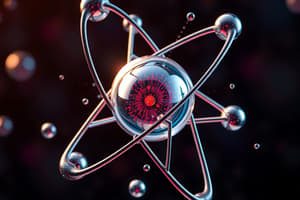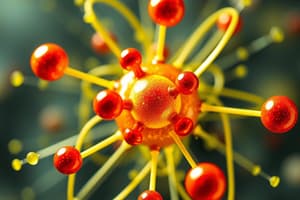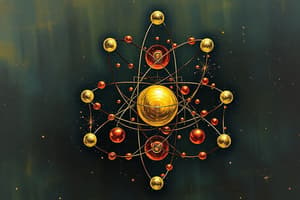Podcast
Questions and Answers
Which formula correctly represents the compound formed by two magnesium atoms and one oxygen molecule?
Which formula correctly represents the compound formed by two magnesium atoms and one oxygen molecule?
- Mg2O (correct)
- Mg2O2
- MgO2
- MgO
Silicon(IV) oxide, SiO2, has a macromolecular structure.
Silicon(IV) oxide, SiO2, has a macromolecular structure.
True (A)
What type of bonding is found in compound X if it melts at 801 °C and conducts electricity when dissolved in water?
What type of bonding is found in compound X if it melts at 801 °C and conducts electricity when dissolved in water?
ionic bonding
The formula for chromium(III) sulfate is ______.
The formula for chromium(III) sulfate is ______.
Which elements in the third period are considered good conductors of electricity?
Which elements in the third period are considered good conductors of electricity?
Match the compounds with their corresponding formulas:
Match the compounds with their corresponding formulas:
Carbon dioxide has a similar structure to that of diamond and silicon(IV) oxide.
Carbon dioxide has a similar structure to that of diamond and silicon(IV) oxide.
Which element exists as diatomic molecules of the type X2 in the third period?
Which element exists as diatomic molecules of the type X2 in the third period?
Which statements are correct about graphite? (Select all that apply)
Which statements are correct about graphite? (Select all that apply)
Hydrogen sulfide has a high boiling point due to its simple molecular structure.
Hydrogen sulfide has a high boiling point due to its simple molecular structure.
What type of lattice structure does magnesium chloride have?
What type of lattice structure does magnesium chloride have?
Magnesium reacts with chlorine to form __________.
Magnesium reacts with chlorine to form __________.
Which substance is a product of respiration?
Which substance is a product of respiration?
What happens to potassium atoms when they react with iodine to form potassium iodide?
What happens to potassium atoms when they react with iodine to form potassium iodide?
Substance D cannot be classified as an element if it consists of two different kinds of atoms.
Substance D cannot be classified as an element if it consists of two different kinds of atoms.
Describe the motion of the ions in solid lithium bromide.
Describe the motion of the ions in solid lithium bromide.
Solid lithium bromide can conduct electricity.
Solid lithium bromide can conduct electricity.
What is meant by the term ionic bond?
What is meant by the term ionic bond?
What describes why potassium iodide has a high melting point?
What describes why potassium iodide has a high melting point?
Match the following descriptions with the appropriate substances:
Match the following descriptions with the appropriate substances:
Carbon dioxide can conduct electricity in solid form.
Carbon dioxide can conduct electricity in solid form.
Calcium nitride is formed when calcium reacts with ______.
Calcium nitride is formed when calcium reacts with ______.
Why can graphite be used as a lubricant?
Why can graphite be used as a lubricant?
What type of structure does silicon (IV) oxide have?
What type of structure does silicon (IV) oxide have?
Pairs of electrons are shared in methane.
Pairs of electrons are shared in methane.
Graphite is considered a ______ conductor of electricity due to the presence of ______ that can move through the structure.
Graphite is considered a ______ conductor of electricity due to the presence of ______ that can move through the structure.
Which of the following substances involve pairs of electrons being shared between atoms?
Which of the following substances involve pairs of electrons being shared between atoms?
Match the following compounds with their respective properties.
Match the following compounds with their respective properties.
Which ions are present in lithium bromide?
Which ions are present in lithium bromide?
Diamond has a macromolecular structure similar to silicon (IV) oxide.
Diamond has a macromolecular structure similar to silicon (IV) oxide.
What is ionic bonding?
What is ionic bonding?
Flashcards
What ions make up potassium fluoride?
What ions make up potassium fluoride?
Potassium fluoride contains potassium ions (K+) and fluoride ions (F-).
What is the formula of the covalent compound formed by atoms X and Y?
What is the formula of the covalent compound formed by atoms X and Y?
The formula of the compound is XY2. The compound contains two atoms of Y for every atom ofX.
What is the formula of the product formed when two magnesium atoms react with one oxygen molecule?
What is the formula of the product formed when two magnesium atoms react with one oxygen molecule?
The product of the reaction is magnesium oxide, with the formula MgO.
What types of bonding are present in compounds X and Y?
What types of bonding are present in compounds X and Y?
Signup and view all the flashcards
Which diagram correctly shows the arrangement of outer electrons in a methane molecule?
Which diagram correctly shows the arrangement of outer electrons in a methane molecule?
Signup and view all the flashcards
Describe the structure of silicon (IV) oxide.
Describe the structure of silicon (IV) oxide.
Signup and view all the flashcards
What are three properties that silicon (IV) oxide and diamond share?
What are three properties that silicon (IV) oxide and diamond share?
Signup and view all the flashcards
Why are the physical properties of carbon dioxide different from those of diamond and silicon (IV) oxide?
Why are the physical properties of carbon dioxide different from those of diamond and silicon (IV) oxide?
Signup and view all the flashcards
Ionic Motion in Solid State
Ionic Motion in Solid State
Signup and view all the flashcards
Ionic Bond
Ionic Bond
Signup and view all the flashcards
Ionic Lattice
Ionic Lattice
Signup and view all the flashcards
Ionic Solid
Ionic Solid
Signup and view all the flashcards
Covalent Bond
Covalent Bond
Signup and view all the flashcards
Giant Covalent Structure
Giant Covalent Structure
Signup and view all the flashcards
Layered Structure
Layered Structure
Signup and view all the flashcards
Delocalized Electrons
Delocalized Electrons
Signup and view all the flashcards
Why is graphite used as a lubricant?
Why is graphite used as a lubricant?
Signup and view all the flashcards
How are ionic compounds formed?
How are ionic compounds formed?
Signup and view all the flashcards
Describe the formation of MgCl2.
Describe the formation of MgCl2.
Signup and view all the flashcards
What are the typical properties of ionic compounds?
What are the typical properties of ionic compounds?
Signup and view all the flashcards
What is a compound?
What is a compound?
Signup and view all the flashcards
What is a macromolecule?
What is a macromolecule?
Signup and view all the flashcards
Why does hydrogen sulfide have a low boiling point?
Why does hydrogen sulfide have a low boiling point?
Signup and view all the flashcards
What is a catalyst?
What is a catalyst?
Signup and view all the flashcards
Structure of Potassium Iodide
Structure of Potassium Iodide
Signup and view all the flashcards
High Melting Point of Potassium Iodide
High Melting Point of Potassium Iodide
Signup and view all the flashcards
Why Carbon Dioxide is a Non-Conductor
Why Carbon Dioxide is a Non-Conductor
Signup and view all the flashcards
Structure of Silicon(IV) Oxide
Structure of Silicon(IV) Oxide
Signup and view all the flashcards
Properties of Silicon(IV) Oxide and Diamond
Properties of Silicon(IV) Oxide and Diamond
Signup and view all the flashcards
Difference in Properties of Carbon Dioxide and Diamond/Silicon(IV) Oxide
Difference in Properties of Carbon Dioxide and Diamond/Silicon(IV) Oxide
Signup and view all the flashcards
Ionic Bonding Definition
Ionic Bonding Definition
Signup and view all the flashcards
Ionic Lattice Definition
Ionic Lattice Definition
Signup and view all the flashcards
Study Notes
Unit 3: Atom Combining Worksheet
- Worksheet topic: Atom Combining
- Subject: Chemistry 0620
- Grade: 9
- Semester: First Semester 2024/2025
- Exam board/programme: IGCSE
- Teacher: Rasha N. Maraqa
Question 1: Potassium Fluoride Ions
- Question: Which diagram correctly shows the ions in potassium fluoride?
- Options: Four diagrams (A, B, C, and D) are provided and labelled with K+ or K− and F+ or F− with electronic configurations
- Answer: The correct diagram shows potassium ion (K+) and fluoride ion (F−) with their respective electron configurations.
Question 2: Covalent Compound Formula
- Question: What is the formula of the covalent compound formed by atoms X and Y, given their electronic structures?
- Options: Four options (A, B, C, and D) are provided with formulas (XY5, XY3, XY, X3Y)
- Answer: The correct formula is XY.
Question 3: Magnesium Oxide Formula
- Question: What is the formula of the product formed when two atoms of magnesium react with one molecule of oxygen?
- Options: Four options (A, B, C, and D) are provided with formulas (MgO, MgO2, Mg2O, Mg2O2)
- Answer: The correct formula is MgO.
Question 4: Bonding Type
- Question: Identify the type of bonding in compounds X and Y, given their properties.
- Compound X melts at 801 °C and is a good electrical conductor when dissolved in water.
- Compound Y boils at 77 °C, is insoluble in water, and is a non-conductor of electricity.
- Options: Four options (A, B, C, and D) are provided with combinations of covalent/ionic bonding for both X and Y.
- Answer: The correct answer is ionic bonding for X and covalent bonding for Y.
Question 5: Methane Diagram
- Question: Which diagram correctly represents the arrangement of outer electrons in a methane molecule?
- Options: Four diagrams (A, B, C, and D) are provided.
- Answer: The correct answer is the matching diagram with a central carbon atom and four outer-shell electrons bonding with four hydrogen atoms.
Question 6: Silicon(IV) Oxide Structure
- Question: Describe the structure of silicon(IV) oxide (SiO2) and list three common properties between silicon(IV) oxide and diamond.
- Answer: Silicon(IV) oxide has a giant/network covalent structure where silicon atoms form strong covalent bonds with four oxygen atoms, creating a continuous, three-dimensional network. Common properties shared with diamond include: -High melting point -Hardness -Insoluble in water
Question 7: Compound Formulae
- Question: Deduce the formulae for chromium(III) sulfate and barium hydroxide using provided ions.
- Answer: Cr2(SO4)3 and Ba(OH)2
Question 8: Third Period Elements
- Question: Explain why Na, Mg, and Al are good conductors of electricity, identify the diatomic molecule, and explain why silicon has the highest melting point in the third period.
- Answer: These elements have delocalized electrons, which can move freely. The element that exists as a diatomic molecule of the type X2 is chlorine (Cl2). Silicon's very high melting point is contributed to its giant covalent structure.
Question 9: Lithium Bromide Electrolysis
- Question: Explain the motion of ions in solid lithium bromide, and define the term 'ionic bond' and 'ionic lattice.
- Answer: The ions in solid lithium bromide do not move, they are fixed in the solid. An ionic bond is the electrostatic attraction between oppositely charged ions. An 'ionic lattice' is a regular arrangement of positive and negative ions.
Question 10: Substances Properties
- Question: Match substances (A-E) with their descriptions (covalent/ionic solid, etc.), based on the table of their melting/boiling points and conductivity properties.
Question 11: Calcium Nitride Diagram
- Question: Draw a diagram of calcium nitride (Ca3N2), showing the charges on the ions and the arrangement of electrons.
Question 12: Graphite Lubrication
- Question: Explain why graphite can be used as a lubricant.
- Answer: Graphite contains delocalized electrons that move freely throughout the structure. The weak forces of attraction between the layers allow the layers to move over each other easily.
Question 13: Shared Electrons
- Question: Identify compounds where electrons are shared between atoms.
- Answer: Methane (CH4), lead bromide (PbBr2), and sodium chloride (NaCl).
Question 14: Drill Tip Materials
- Question: Identify correct statements about materials used for drill tips and lubricants.
- Answer: Diamond is hard and does not conduct electricity, making it suitable for drill tips. Graphite is soft and conducts electricity, making it a suitable lubricant.
Question 15: Carbon Containing Substances
- Question: Classify the substances (A to F) containing carbon based on their structures.
Question 16: Magnesium Chloride Ions
- Question: Draw diagrams to show the electronic structures of magnesium and chloride ions in magnesium chloride (MgCl2), indicating the charges.
Question 17: Ethyne Dot-and-Cross Diagram
- Question: Draw a dot-and-cross diagram for ethyne (H−C≡C−H), displaying outer shell electrons.
Question 18: Hydrogen Sulfide Dot-and-Cross Diagram
- Question: Draw a dot-and-cross diagram for hydrogen sulfide (H2S), showing outer shell electrons.
Question 19: Hydrogen Sulfide Boiling Point
- Question: Describe why hydrogen sulfide has a low boiling point.
- Answer: The weak intermolecular forces between simple molecules result in a low boiling point.
Question 20: Chlorine Molecule Dot-and-Cross Diagram
- Question: Draw a dot-and-cross diagram for a chlorine molecule (Cl2).
Question 21: Substance Properties (R, S, T, U)
- Question: Identify and classify four compounds, R, S, T, and U (based on diagrams) by identifying their properties (e.g., ionic structure, electrical conductivity when solid).
Question 22: Covalent Bonding (R, S, T, U)
- Question: Identify two covalent bonded substances among R, S, T, or U.
Question 23: Potassium Iodide Properties
- Question: Describe the electron transfer between potassium and iodine atoms to form potassium iodide (KI). Explain the structure of potassium iodide and the reason for its high melting point.
Question 24: Carbon Dioxide Conductivity
- Question: Explain why carbon dioxide is a non-conductor of electricity in terms of particles
Question 25: Silicon(IV) Oxide Properties
- Question: Describe the structure of silicon (IV) oxide (SiO2) as a macromolecule. Also list three common properties shared by silicon (IV) oxide and diamond.
Question 26: Ion Formulae
- Question: Deduce the formulas for selenide and gallium ions.
Question 27: Lithium Bromide Electrolysis
- Question: Explain why solid lithium bromide is a poor conductor of electricity. Define ionic bonding and ionic lattice.
Question 28: Graphite and Diamond Structures
- Question: Describe the structures of graphite and diamond
Question 29: Strontium Oxide Diagram
- Question: Draw a diagram of strontium oxide (SrO) showing the charges on the ions and the arrangement of valence electrons.
Question 30: Graphite Properties (Structure Explanation)
- Question: (a) Explain graphite's softness and electrical conductivity using its structure. (b) Explain diamond's hardness using its structure. (c) Compare graphite and diamond's electrical conductivity based on structure. (d) Provide two uses of graphite based on its properties.
Studying That Suits You
Use AI to generate personalized quizzes and flashcards to suit your learning preferences.




